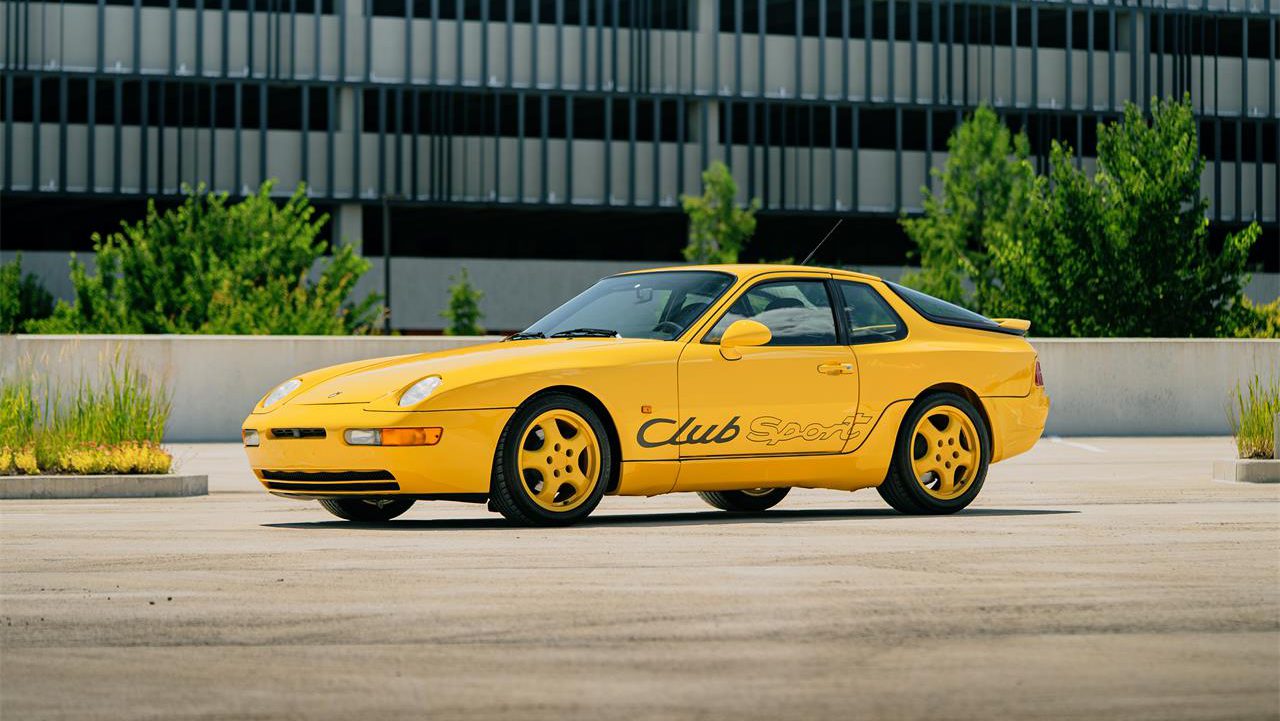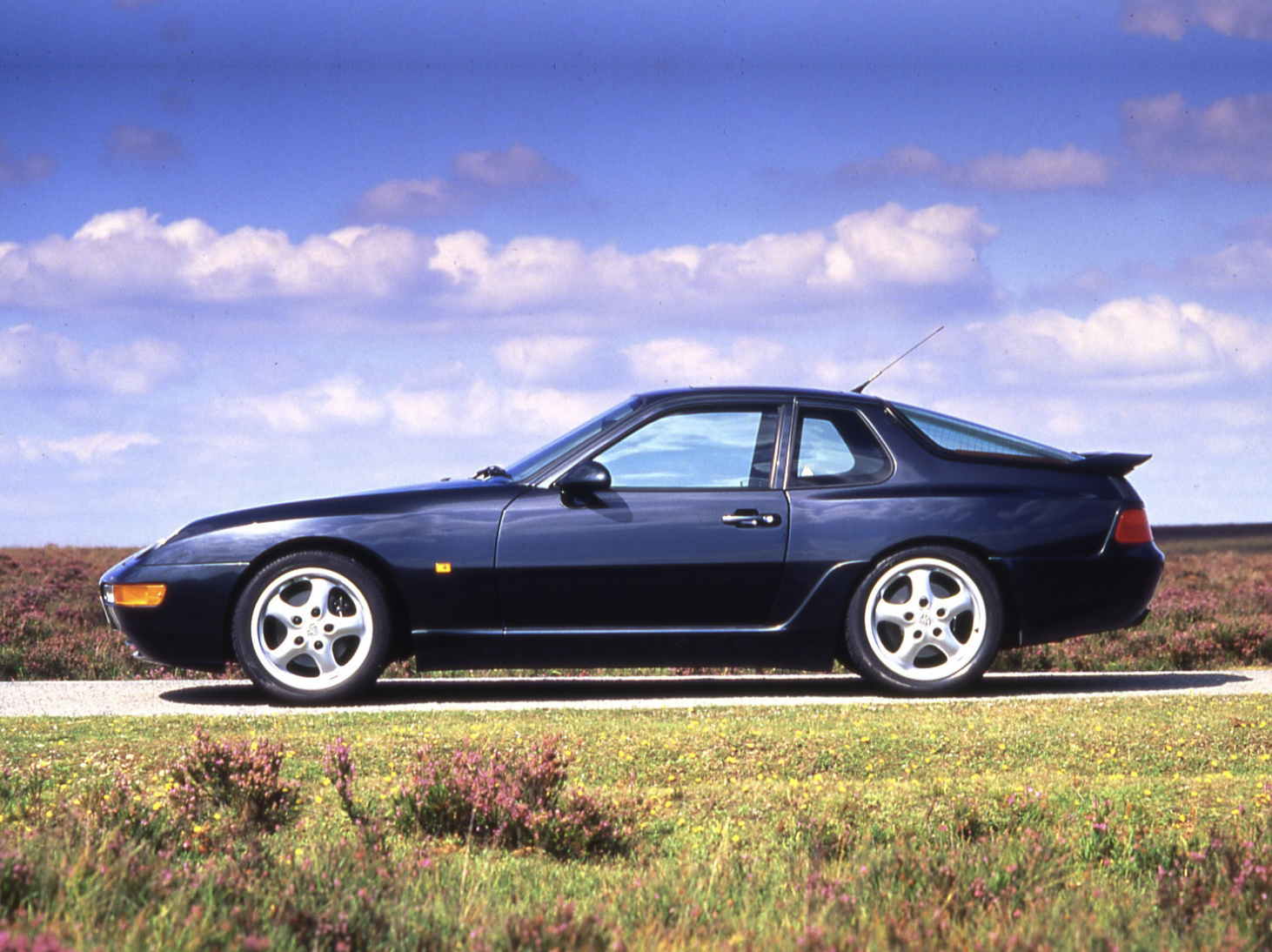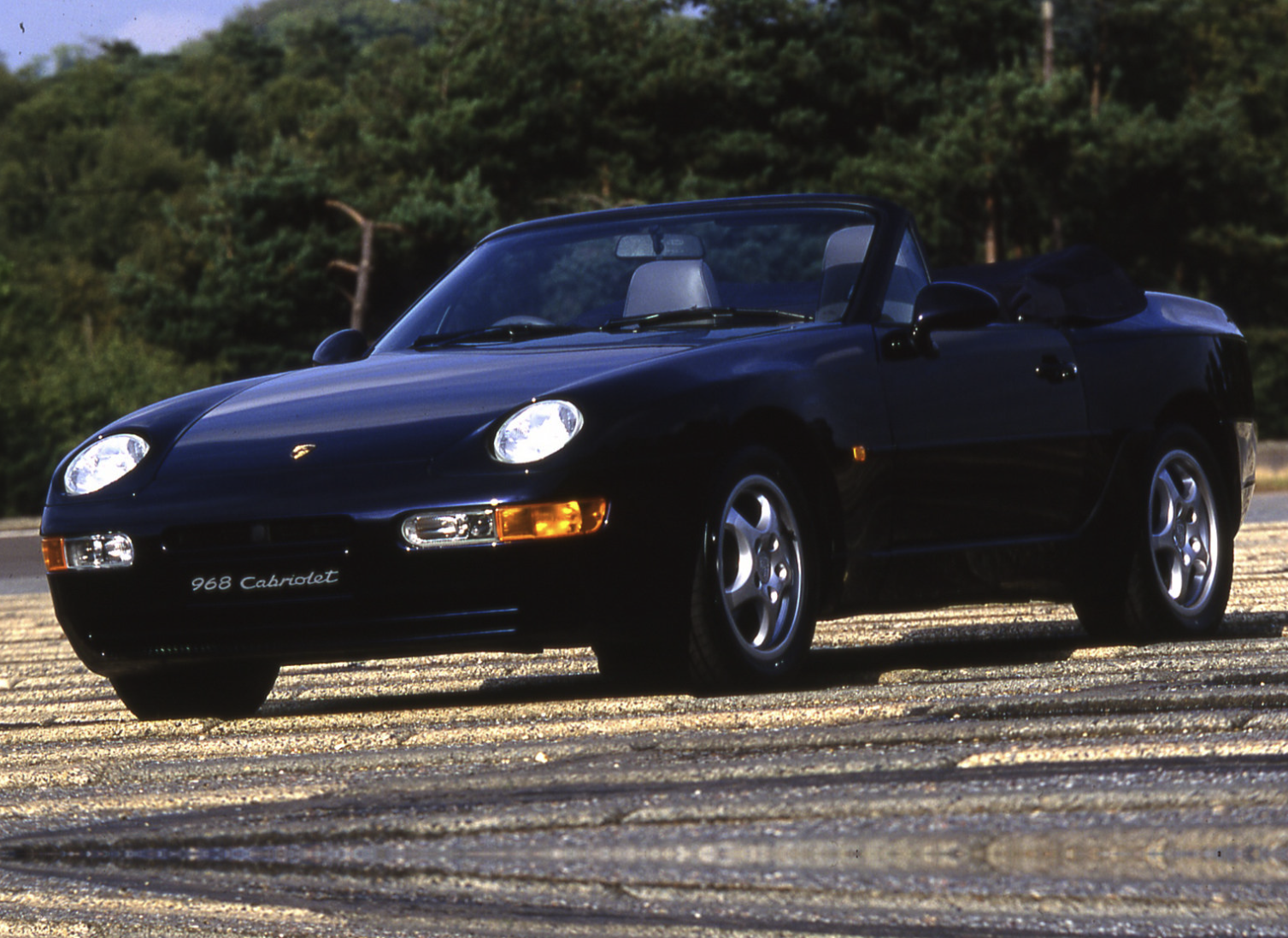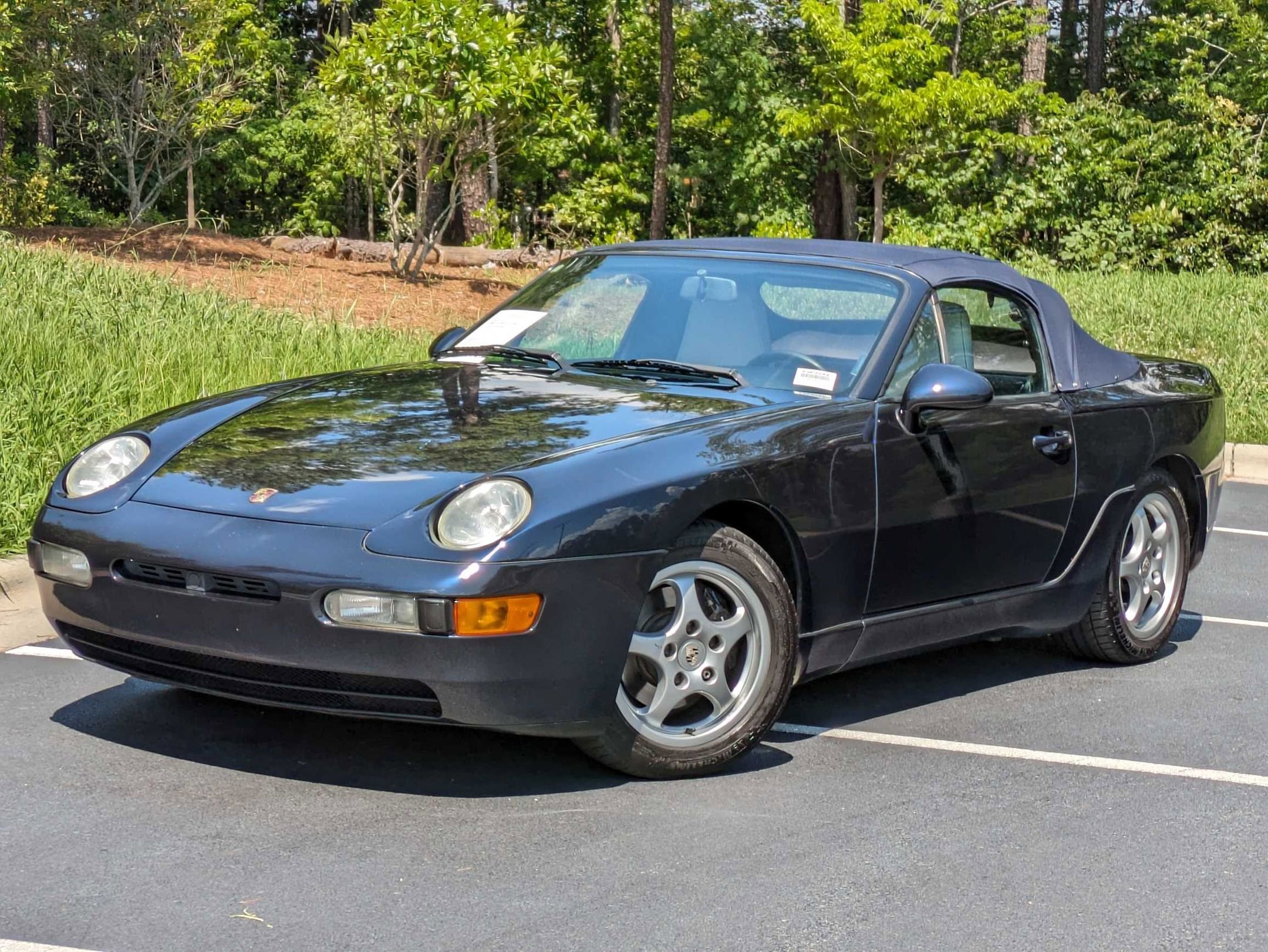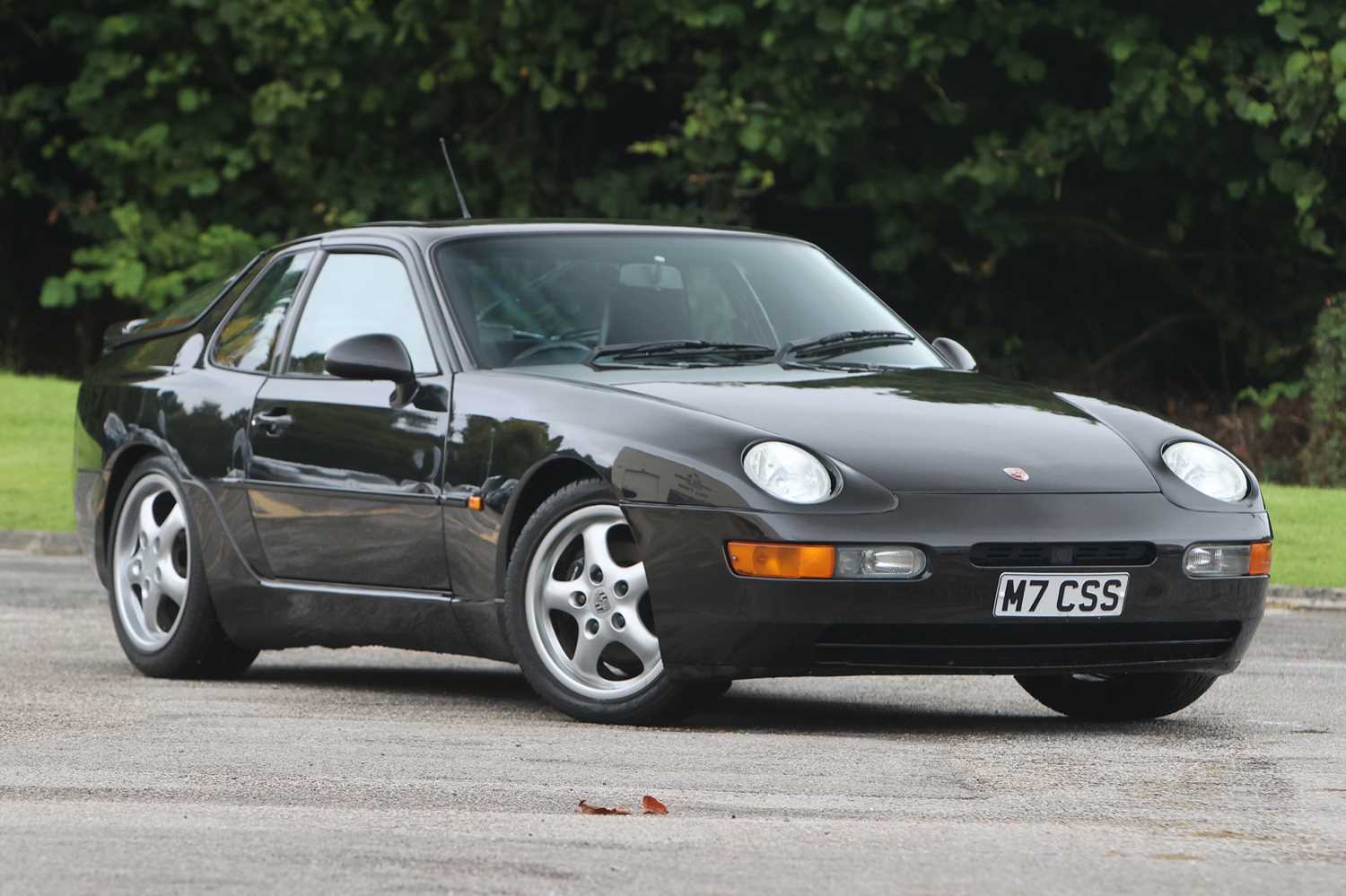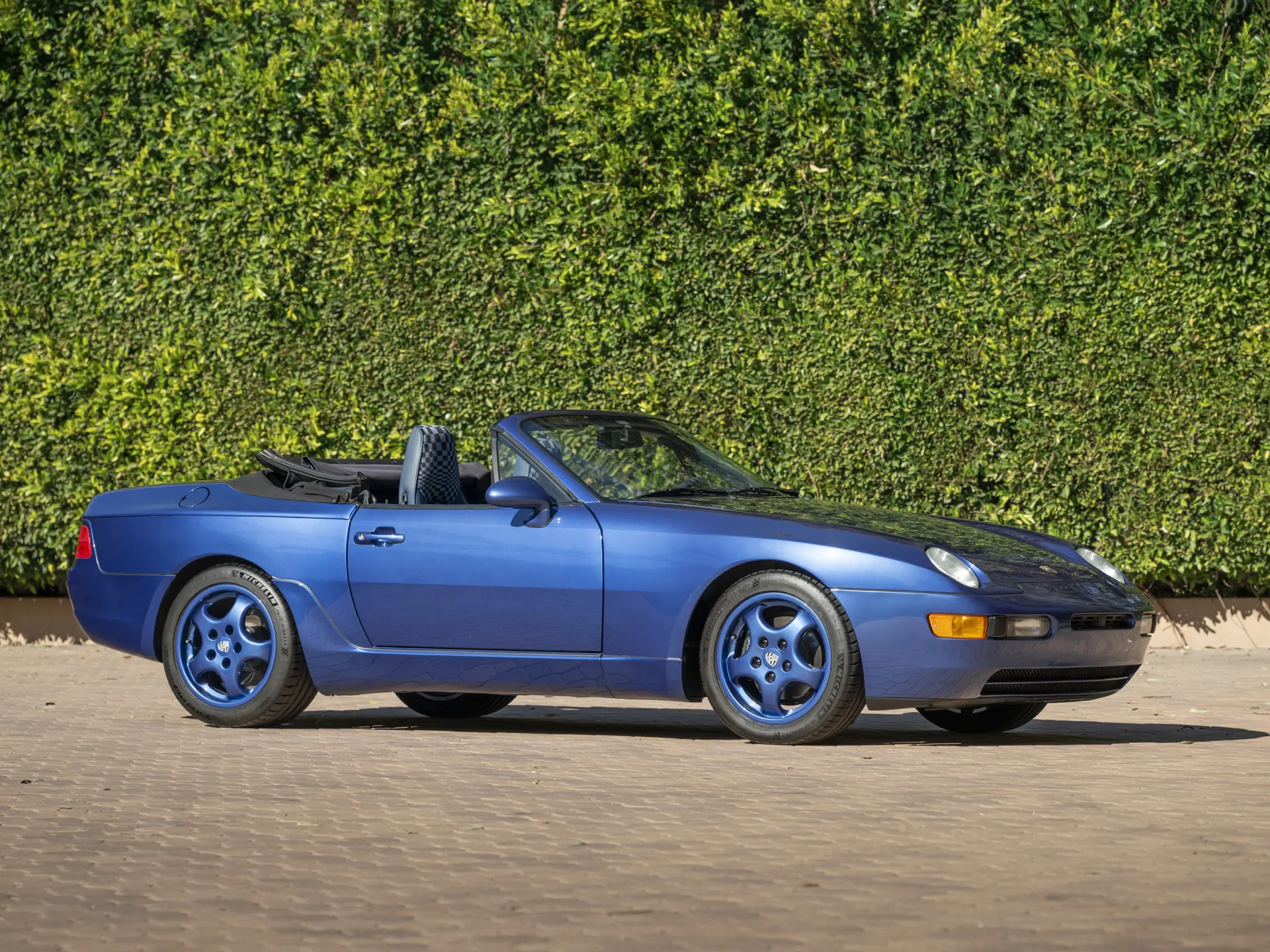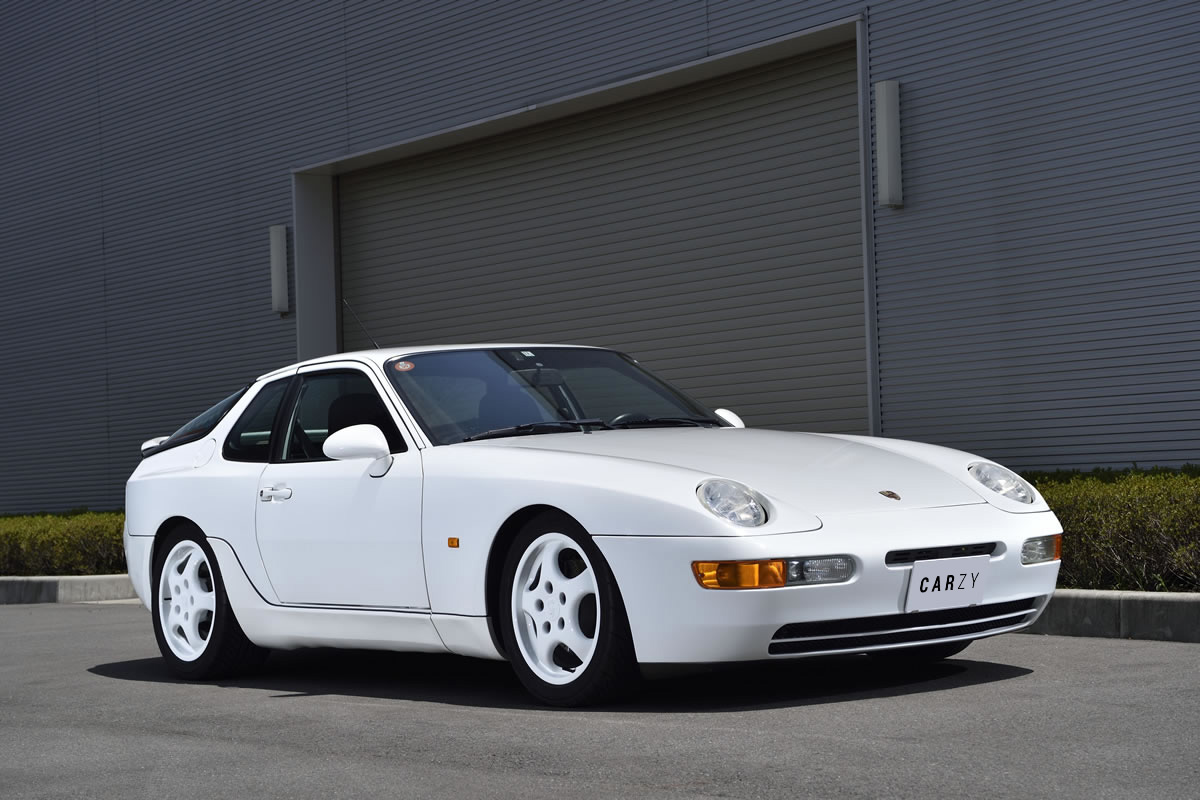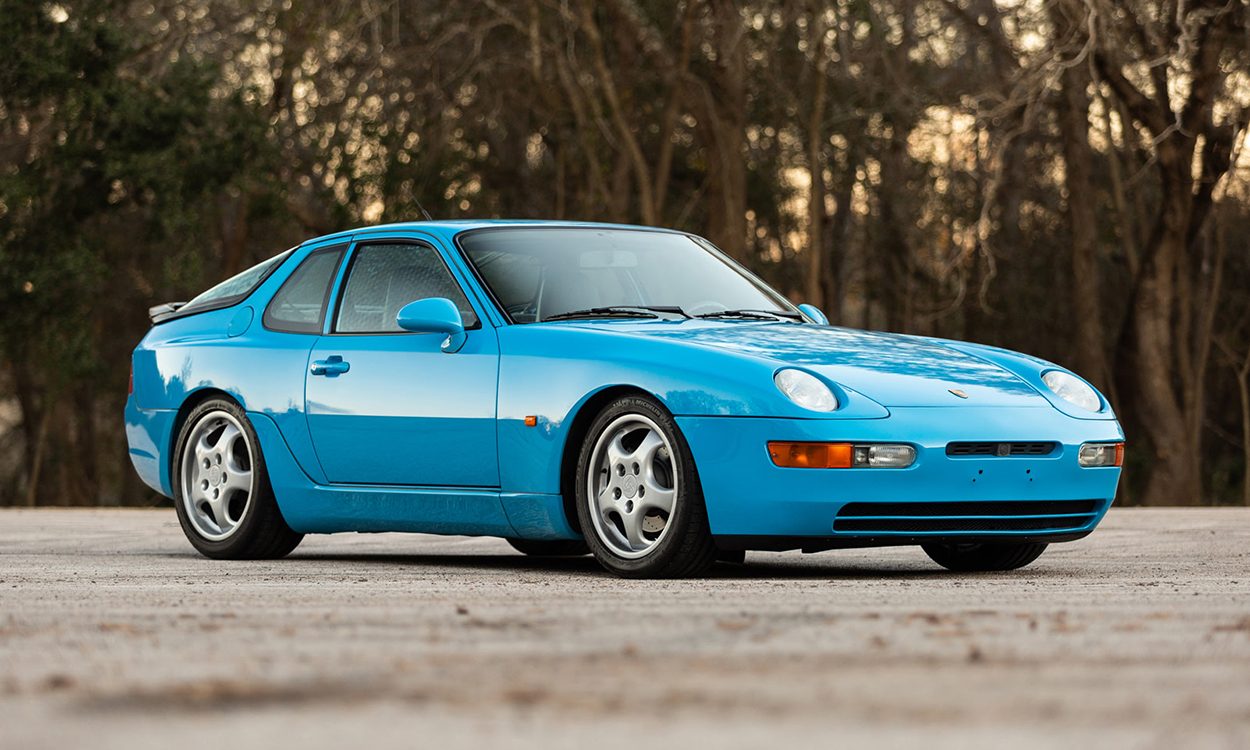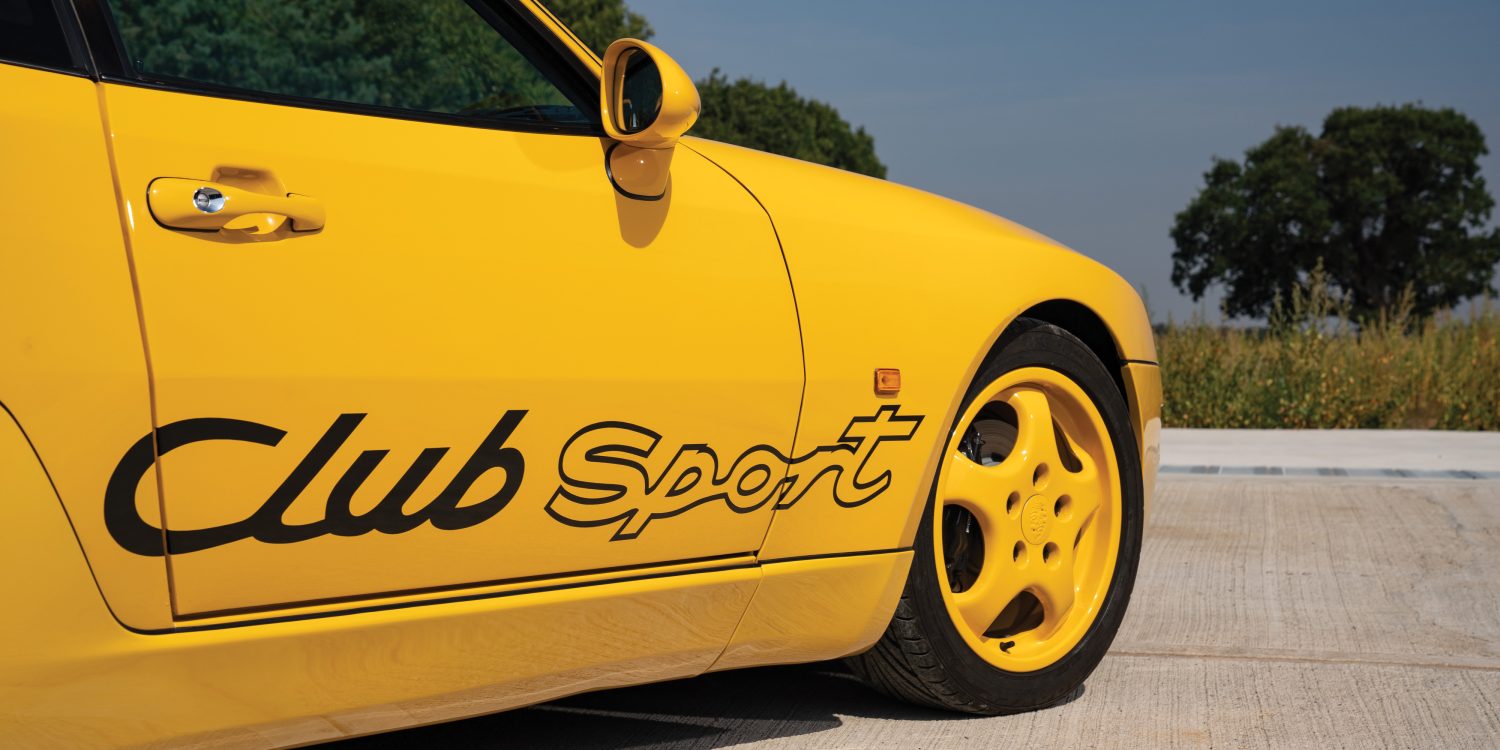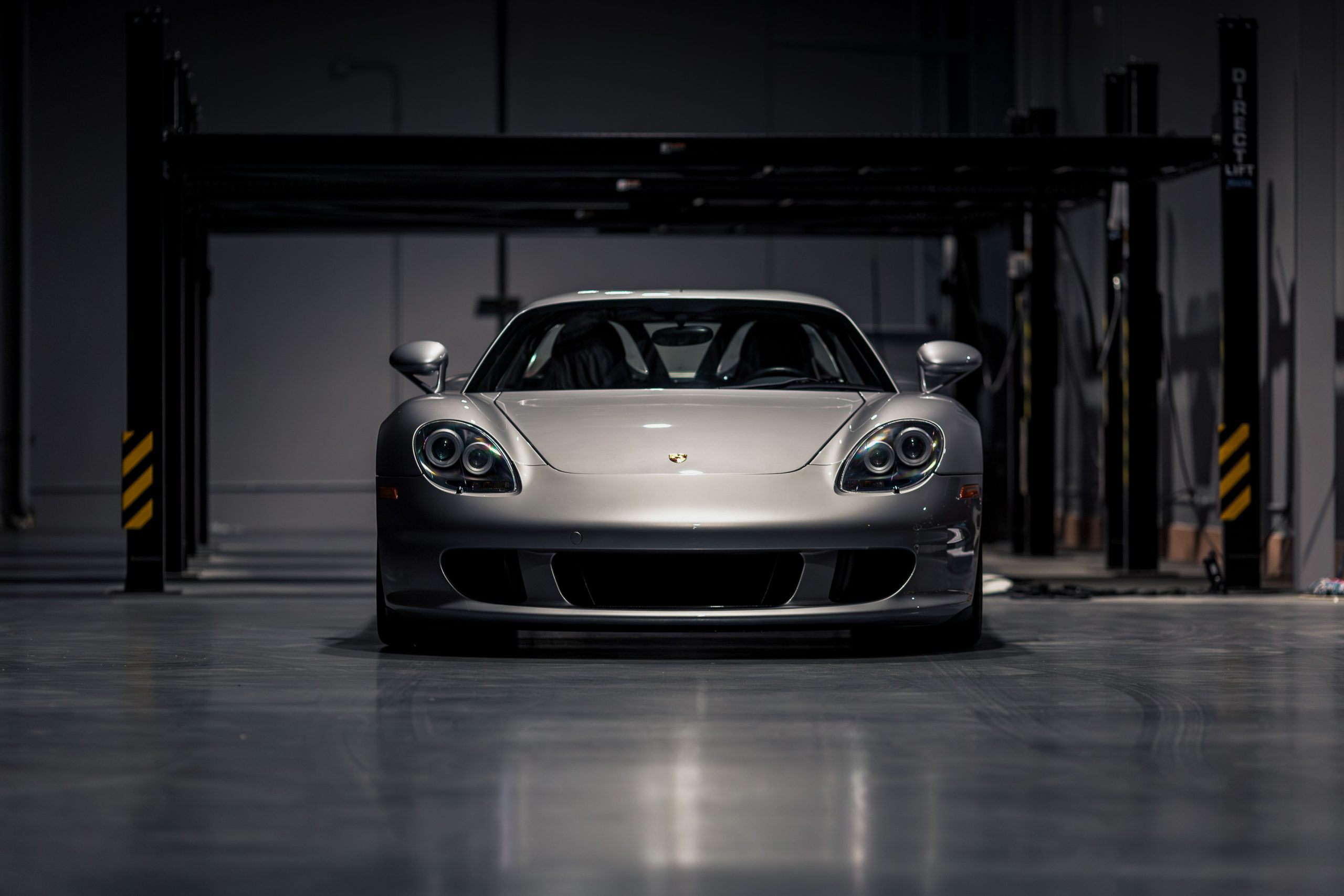Porsche 968 Buyer's Guide
Buying a Porsche 968? Our (Seriously In-Depth) Buyer’s Guide Covers Key Models, Potential Issues, Market Values, Expert Tips, What To Expect & MUCH More.
Introduced as Porsche’s successor to the beloved Porsche 944, the Porsche 968 represented the final and most refined chapter in the automaker's front-engined, four-cylinder transaxle lineage. Produced from 1992 to 1995, the 968 combined evolved styling cues with substantial mechanical improvements, notably featuring a robust 3.0-liter inline-four engine with variable valve timing—a first for Porsche. Delivering 236 horsepower and exceptional balance, the 968 offered a sophisticated driving experience that seamlessly blended spirited performance with everyday practicality, setting itself apart as a highly rewarding sports car.
Today, the Porsche 968 stands out as an increasingly desirable classic, offering enthusiasts exceptional build quality, distinctive styling, and modern usability unmatched by many of its contemporaries. Available in both Coupe and stylish Cabriolet variants, as well as the track-inspired, limited-production 968 Club Sport, there's a 968 suited to every driving preference—from relaxed weekend touring to spirited track days. Its combination of rarity (fewer than 13,000 units were produced worldwide) and dependable, manageable upkeep makes it a uniquely appealing proposition for collectors and enthusiasts alike.
In this comprehensive Porsche 968 Buyer’s Guide, we’ll dive deep into the specifics you need to find and secure the right example. From key models and variant differences to potential issues, current market values, and expert ownership tips, you'll be equipped with everything necessary to confidently navigate the buying process. Whether your goal is a reliable classic daily driver, an appreciating investment, or simply a Porsche offering pure driving enjoyment, the 968 delivers on all fronts—making now an excellent moment to explore ownership of one of Porsche’s most underrated gems.
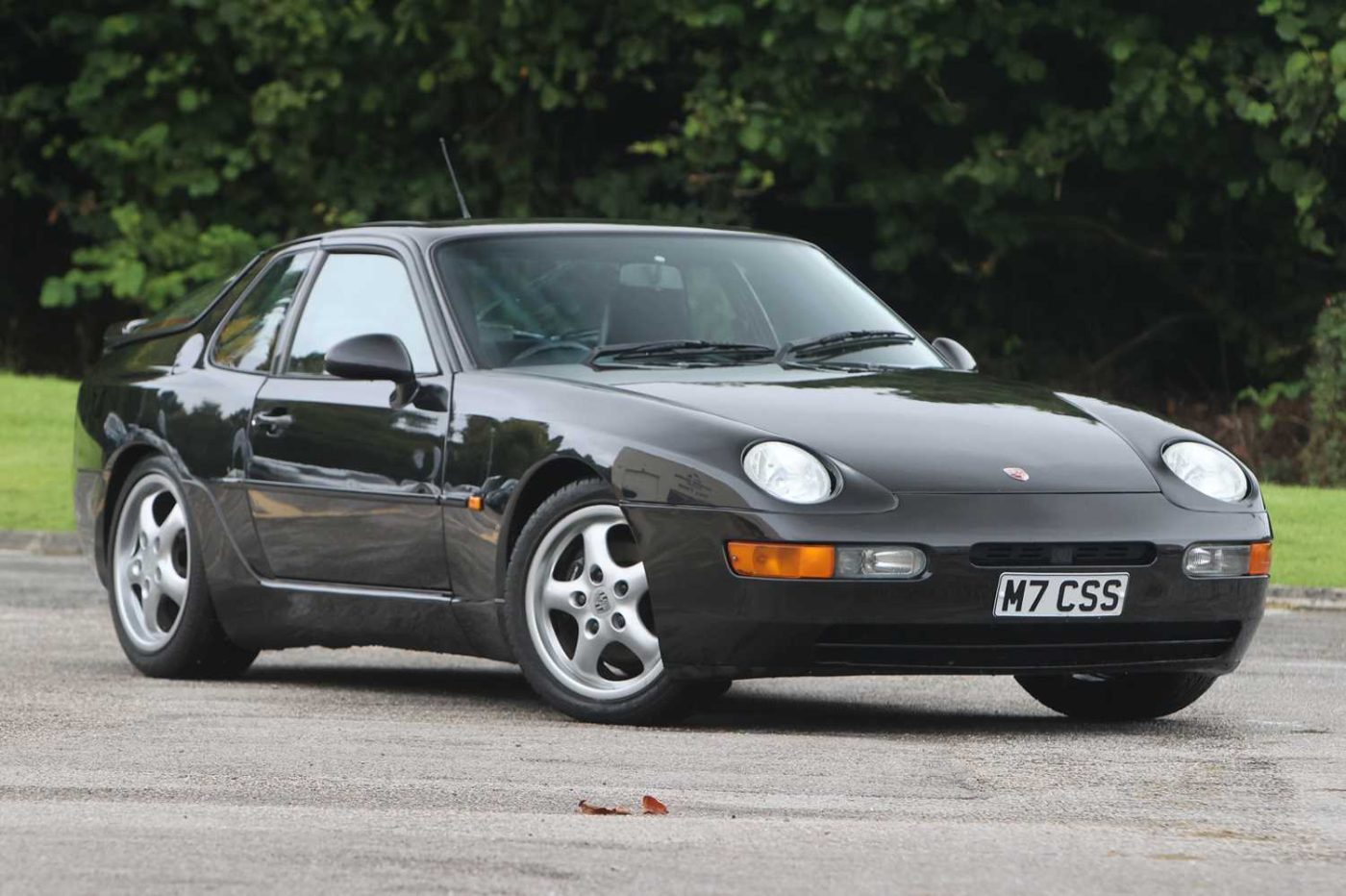
Why the Porsche 968 is a Unique Classic to Buy
The Porsche 968 is uniquely positioned as one of the most sophisticated, refined, and underrated classics within Porsche’s lineage, marking the final and most advanced chapter of Porsche’s transaxle, front-engined sports car era. Introduced in 1992 as a successor to the highly respected Porsche 944, the 968 was far more than merely an evolution—it represented a significant leap forward in technology, engineering, and build quality. Its robust 3.0-liter inline-four engine, featuring Porsche’s innovative VarioCam variable valve timing system, delivered impressive torque and a lively 236 horsepower, giving the car performance credentials that remain relevant even today.
One key aspect of the Porsche 968’s unique appeal is its rarity. Produced only between 1992 and 1995, fewer than 13,000 units were built worldwide. Compared to more ubiquitous classic models like the Porsche 911 or even the 944, the 968 provides an exclusive ownership experience without the astronomical costs typically associated with limited-production classics. Its sleek, timeless styling—featuring design cues reminiscent of the iconic 928—further underscores its distinction and ensures the 968 continues to attract appreciative attention from collectors and enthusiasts alike.
Beyond rarity and style, the Porsche 968's impressive practicality makes it an exceptionally livable classic car. Designed with usability in mind, it offers spaciousness, comfortable ergonomics, modern reliability, and handling characteristics ideal for everyday use. The availability of the Coupe and elegant Cabriolet variants, along with the rare and sought-after track-focused Club Sport model, means potential buyers can select a 968 ideally suited to their driving preferences. Its near-perfect weight distribution, responsive steering, and well-balanced suspension make the 968 not just a collectible, but a genuinely enjoyable driver’s car that rewards enthusiasts with every journey.
Lastly, the Porsche 968 has begun to gain momentum in collector circles, signaling its potential as an appreciating asset. While it remains attractively priced compared to many vintage Porsche alternatives, especially air-cooled 911 models, values have steadily risen in recent years as recognition of the car’s inherent strengths grows. This combination of affordability, exclusivity, practicality, and upward market trajectory places the Porsche 968 in a compelling niche, offering enthusiasts a uniquely balanced proposition of investment potential, driving enjoyment, and classic Porsche prestige.
Porsche 968 Variants - A Quick Primer for Potential Buyers On The Variants & Specials To Think About.
We already have ultimate guide to the Porsche 968 so we don't want to repeat everything here. Instead, we will give you a quick primer and summary about the main 968 variants, some of the core model year changes and we will talk about some special editions worth noting as you think about your potential purchase.
Key Variants & Differences
The Porsche 968, produced from 1992 to 1995, was offered in several distinct variants, each tailored to different driving experiences and enthusiast preferences. Understanding these variations helps prospective buyers identify the ideal 968 model to suit their specific needs and objectives. Here’s an expert breakdown of the key variants and their notable differences.
Porsche 968 Coupe (Standard Model)
The standard 968 Coupe is the foundation of the range, powered by Porsche’s robust 3.0-liter inline-four engine featuring VarioCam variable valve timing, delivering 236 horsepower and strong mid-range torque. It features excellent balance, handling precision, and refined driving characteristics. Standard Coupes came generously equipped, with amenities including air conditioning, power windows, power steering, and comfortable, supportive seats. These models offer the ideal blend of performance, comfort, and practicality, making them attractive options for daily drivers and classic enthusiasts alike.
Porsche 968 Cabriolet
The 968 Cabriolet brought open-top motoring into the lineup, appealing to enthusiasts seeking a more stylish, leisurely driving experience. Mechanically identical to the Coupe, the Cabriolet retained the performance and handling capabilities of its fixed-roof sibling but with added sophistication and the enjoyment of top-down cruising. The Cabriolet’s power-operated fabric roof, reinforced chassis structure, and enhanced interior trim distinguish it as a refined grand-tourer, ideal for those prioritizing lifestyle and weekend enjoyment over outright performance.
Porsche 968 Club Sport (CS)
Arguably the most celebrated variant among Porsche enthusiasts, the 968 Club Sport (produced primarily for the European market) was a lighter, more focused version aimed squarely at driving purists. Introduced in 1993, the Club Sport featured reduced weight through deletion of rear seats, air conditioning, power windows, and other non-essential equipment. It also received uprated suspension, sportier seats, a lowered ride height, and distinctively painted wheels, making it ideal for spirited driving and occasional track use. The Club Sport's enhanced driving dynamics and limited production numbers have made it highly sought after among collectors today.
Porsche 968 Turbo S and Turbo RS (Ultra-Rare Limited Editions)
Among the rarest and most exclusive Porsche 968 variants are the factory-built 968 Turbo S and the racing-oriented Turbo RS, produced in extremely limited numbers. Both employed a turbocharged version of the 3.0-liter inline-four engine, with power outputs significantly elevated to approximately 305 hp in the Turbo S and even higher in the racing-focused Turbo RS. Featuring aggressive aerodynamic enhancements, reinforced chassis components, upgraded brakes and suspension, and stripped-out interiors, these ultra-rare models are highly collectible and command substantial premiums on today’s market.
Selecting the right Porsche 968 variant involves considering your driving style, desired performance level, budget, and collectibility goals. While the standard Coupe and Cabriolet offer versatile and refined driving experiences, the Club Sport remains the driver's favorite for enthusiasts who prioritize dynamic purity and driving enjoyment. Meanwhile, the extremely limited Turbo S and RS versions cater primarily to high-end collectors seeking exclusivity, rarity, and top-tier performance.
Model Year Changes (1992-1995)
Understanding the model-year changes of the Porsche 968 is essential for prospective buyers, as it helps determine the most desirable versions and identify the incremental improvements Porsche made during its short yet impactful production run from 1992 to 1995. Here’s a detailed expert overview of these subtle yet notable annual changes:
1992: Introduction of the Porsche 968
The Porsche 968 launched in 1992, replacing the 944 S2, and showcased substantial advancements in design, technology, and refinement.
Featuring Porsche’s newly developed 3.0-liter inline-four engine with VarioCam variable valve timing, the initial model year delivered 236 horsepower and impressive torque. The styling received significant updates, including smoother lines, integrated bumpers, redesigned lighting, and a modernized interior with improved materials, better ergonomics, and upgraded seats.
1993: Launch of the 968 Club Sport
The most significant change for 1993 was the introduction of the track-oriented Porsche 968 Club Sport (CS), initially offered in Europe.
The Club Sport was lighter, approximately 100 kilograms (220 lbs) less than the standard car, achieved through deleting rear seats, sound-deadening materials, and non-essential luxuries such as air conditioning and power windows. It featured stiffer suspension tuning, lowered ride height, sports seats, and visually distinct color schemes with unique alloy wheels. This model year solidified the 968’s enthusiast-focused credentials, making it particularly sought after today.
1994: Minor Refinements and Equipment Updates
For 1994, Porsche made incremental refinements, mainly focusing on minor reliability improvements, suspension tuning, and additional convenience features. Air conditioning became standard in many markets, and Porsche also subtly enhanced interior quality and noise insulation.
The Cabriolet benefited from small improvements to its roof mechanism, enhancing reliability and ease of use. Additionally, in certain markets, previously optional equipment such as airbags and premium audio systems became standard, further enhancing overall comfort and usability.
1995: Final Model Year and Limited Production
1995 marked the Porsche 968’s final production year, making these late-production examples notably rare and desirable among collectors.
Although no substantial mechanical or design updates were implemented, Porsche refined build quality and fit-and-finish further, ensuring the last models delivered peak refinement. Final-year 968s, particularly in markets like North America, often came heavily optioned, reflecting Porsche's push to move remaining inventory. This rarity, combined with their high specification and refined build quality, has made 1995 models particularly appealing to collectors.
While the Porsche 968 underwent relatively few major changes during its brief production run, these incremental enhancements—particularly the introduction of the Club Sport in 1993 and improvements to comfort and quality through 1995—make certain model years stand out to enthusiasts and collectors.
Understanding these subtleties can significantly enhance the ownership experience and future value appreciation of this distinctive Porsche classic.

Porsche 968 Market Value & Pricing
The Porsche 968 has experienced steady appreciation in recent years, reflecting a growing recognition among collectors and enthusiasts of its rarity, refinement, and position as the last of Porsche's four-cylinder, front-engine transaxle lineage. Standard 968 Coupes currently offer a compelling entry point, typically ranging between $20,000 and $35,000 for well-maintained examples, depending on mileage, condition, and maintenance history. Cabriolet variants generally command a modest premium due to their lower production numbers and increased desirability as stylish grand tourers, often priced from around $25,000 to upwards of $40,000 for pristine, low-mileage cars.
The 968 Club Sport—particularly popular with enthusiasts for its driver-focused purity—commands significantly higher values, typically ranging from $40,000 to $60,000 or even more, especially in excellent condition and rare color combinations. At the pinnacle are the extremely limited-production models such as the 968 Turbo S, whose values easily surpass six figures due to rarity and performance heritage. Overall, the Porsche 968 remains attractively priced compared to more mainstream classic Porsches, making it a compelling purchase for buyers looking to combine genuine collectibility with enjoyable usability and potential investment upside.
What Are 968s Worth?
Here’s a detailed breakdown of Porsche 968 values by condition and model type, from rough project cars to concours-quality collector pieces. The 968 has grown in popularity and value in recent years, especially as the vintage Porsche market matures and enthusiasts turn to transaxle cars for their balance, performance, and affordability.
Project Cars & Non-Runners
$10,000 – $18,000
These are high-mileage, neglected, or non-running 968s. Expect cosmetic wear, torn interiors, faded paint, electrical issues, or deferred maintenance (like overdue timing belt service or clutch replacements). These cars may have sat for years, carry salvage titles, or show signs of amateur modifications. They’re best suited for skilled DIYers—but be warned: bringing one up to standard can easily cost more than buying a better example up front.
Driver-Quality Cars With Needs
$18,000 – $28,000
These are roadworthy and generally solid cars that may have cosmetic flaws, older resprays, worn upholstery, or incomplete service records. They typically have over 100,000 miles and may need suspension work, a timing belt service, or other catch-up maintenance. They offer a great entry point into 968 ownership, especially for enthusiasts who want to drive and enjoy the car without worrying about concours-level presentation.
Well-Maintained Drivers
$28,000 – $40,000
These cars are well-kept, clean, and properly maintained, often with partial or complete service histories. Paint and interior are presentable, mileage is usually in the 70k–100k range, and major services like timing belt/water pump and clutch may already be done. These are ideal for buyers looking for a solid long-term driver with strong usability and moderate future appreciation potential.
Excellent, Low-Mileage
$40,000 – $60,00
This range includes low-mileage, original 968s in excellent cosmetic and mechanical condition. These cars are often garage-kept, have full documentation, and come in desirable color and option combinations. Both coupe and cabriolet versions appear here, with a premium for rare factory specs or color combos. At this level, buyers expect recent service, minimal wear, and originality.
Collector-Grade & Rare Models
$60,000 – $90,000+
At the top of the market are investment-grade 968s, including ultra-low mileage (under 30k) showroom examples, as well as rare factory colors or highly optioned cars and Club Sport (CS) models in Europe. The 968 Turbo S or Turbo RS (extremely rare, six-figure territory if available) are also in this territory (but at the super top). These cars are often in concours condition, fully documented.
Factors That Affect Value
The Porsche 968 has become a rising star in the classic Porsche market, thanks to its rarity, refinement, and position as the last evolution of the brand’s front-engine, rear-transaxle platform. Values have been climbing steadily over the last decade, and today, a number of key factors influence what a 968 is worth—whether it’s a daily driver, a weekend cruiser, or a collector-grade car. Here’s a breakdown of the most important value drivers:
1. Model and Body Style
The 968 was offered in both coupe and cabriolet body styles, with the coupe generally commanding higher values due to its structural rigidity and lower production numbers. Even more valuable are limited-production models like the 968 Club Sport (Europe-only), 968 Turbo S, and Turbo RS, which are extremely rare and highly sought after by collectors.
2. Condition and Mileage
As with any classic, condition is king. Low-mileage, well-preserved cars with original paint, clean interiors, and no rust or accident history command the highest prices. Mechanical condition also matters—buyers will pay a premium for cars with recent timing belt service, clutch replacement, and suspension upkeep. Cars with over 100,000 miles can still be valuable if well-maintained, but low-mileage examples (under 50k) are especially prized.
3. Service History and Documentation
A full, documented service history adds considerable value. The 968 requires regular timing belt and water pump service (every 4–5 years or ~40k miles), and a car with records showing timely care is worth far more than one with an unknown history. Original window stickers, manuals, maintenance logs, and matching-number verification also boost desirability.
4. Originality vs. Modifications
Collectors and purists prefer original, unmodified cars, especially those with factory paint, interior, and wheels. Light, reversible upgrades (such as suspension improvements or OEM+ wheels) might be acceptable, but heavily modified cars—especially engine swaps, aftermarket body kits, or stripped interiors—tend to sell for less. The closer a car is to its factory spec, the more valuable it is in the long term.
5. Color and Factory Options
Factory colors can have a surprising impact on value. Rare or desirable hues like Speed Yellow, Riviera Blue, Maritime Blue, or Amethyst Metallic command premiums, especially when paired with a contrasting or rare interior (linen, burgundy, etc.). Well-optioned cars with limited-slip differentials, sport seats, or rare wheels also tend to be more desirable.
6. Market Trends and Rarity
With just over 12,000 968s built for North America, and fewer than 5,000 coupes, these cars are already rare—and that scarcity is only increasing. As interest grows in analog, usable classics with everyday drivability, the 968 is gaining traction as a smart collector car. The rising tide in transaxle Porsche appreciation (including 944s and 928s) is also lifting 968 values across the board.
Investment Potential
The Porsche 968 has quietly transformed from an overlooked ‘90s transaxle into a serious collector’s car with real investment upside. As the final evolution of Porsche’s front-engine, rear-transaxle lineage—and the last four-cylinder Porsche until the 718 Cayman/Boxster—it holds a unique place in the brand’s history. Its combination of rarity, refinement, and real-world usability makes it a compelling long-term investment for both collectors and enthusiasts.
What makes the 968 so appealing from an investment standpoint is low production numbers and growing appreciation for analog-era Porsches. With only about 12,776 coupes and cabriolets produced for North America between 1992 and 1995, the 968 is one of the rarest Porsche models of the modern era. Add in the fact that it was the last Porsche with pop-up headlights, rear-wheel drive, and a belt-driven camshaft, and you have a perfect storm of nostalgia and engineering pedigree that collectors crave.
Which Porsche 968 Models Have the Strongest Investment Potential?
1992–1995 968 Coupe (Manual): The standard coupe with a 6-speed manual transmission is already seeing strong price appreciation. It offers the most rigid platform and is increasingly viewed as the purest 968 experience. Low-mileage, unmodified examples with rare factory options or colors (like Speed Yellow or Maritime Blue) are leading the market.
1992–1995 968 Cabriolet (Manual): While convertibles traditionally lag behind coupes in value, manual cabriolets are catching up fast—especially in excellent condition or with low mileage. Rarity helps: only a few thousand cabriolets were sold in the U.S., and many came with Tiptronic automatics, making manuals more desirable.
1993–1995 968 Club Sport (Europe-only): A stripped-down, lightweight, track-focused version that never came to the U.S. from the factory. These are highly collectible overseas and are starting to show up stateside through importation. With fewer than 2,000 made, prices have climbed steeply and show no signs of slowing.
968 Turbo S / Turbo RS: These are unicorns—factory-built, limited-run, turbocharged race variants with extremely low production (fewer than 20 combined). Prices are well into six figures, and they rarely come up for sale. These are blue-chip Porsche collectibles, likely to continue appreciating as the rarest and fastest of the transaxle era.
The Porsche 968 is no longer a sleeper—it’s an emerging icon. Rising values of earlier transaxle models (like the 944 Turbo S) have pulled the 968 up with them, and many collectors are now recognizing it as the most refined and usable car of the series. With modern creature comforts, strong reliability, and timeless styling, it’s one of the few classics you can confidently drive and enjoy—while still watching it appreciate.
If you’re shopping for long-term upside, look for manual coupes with original paint, low mileage, full documentation, and rare factory options. These are the cars that will lead the charge as the 968 continues its climb into the spotlight.
Recent Porsche 968 Values & Market Sales Trends
Below, our friends at Classic.com chart recent sales and trends in the Porsche 968 market.
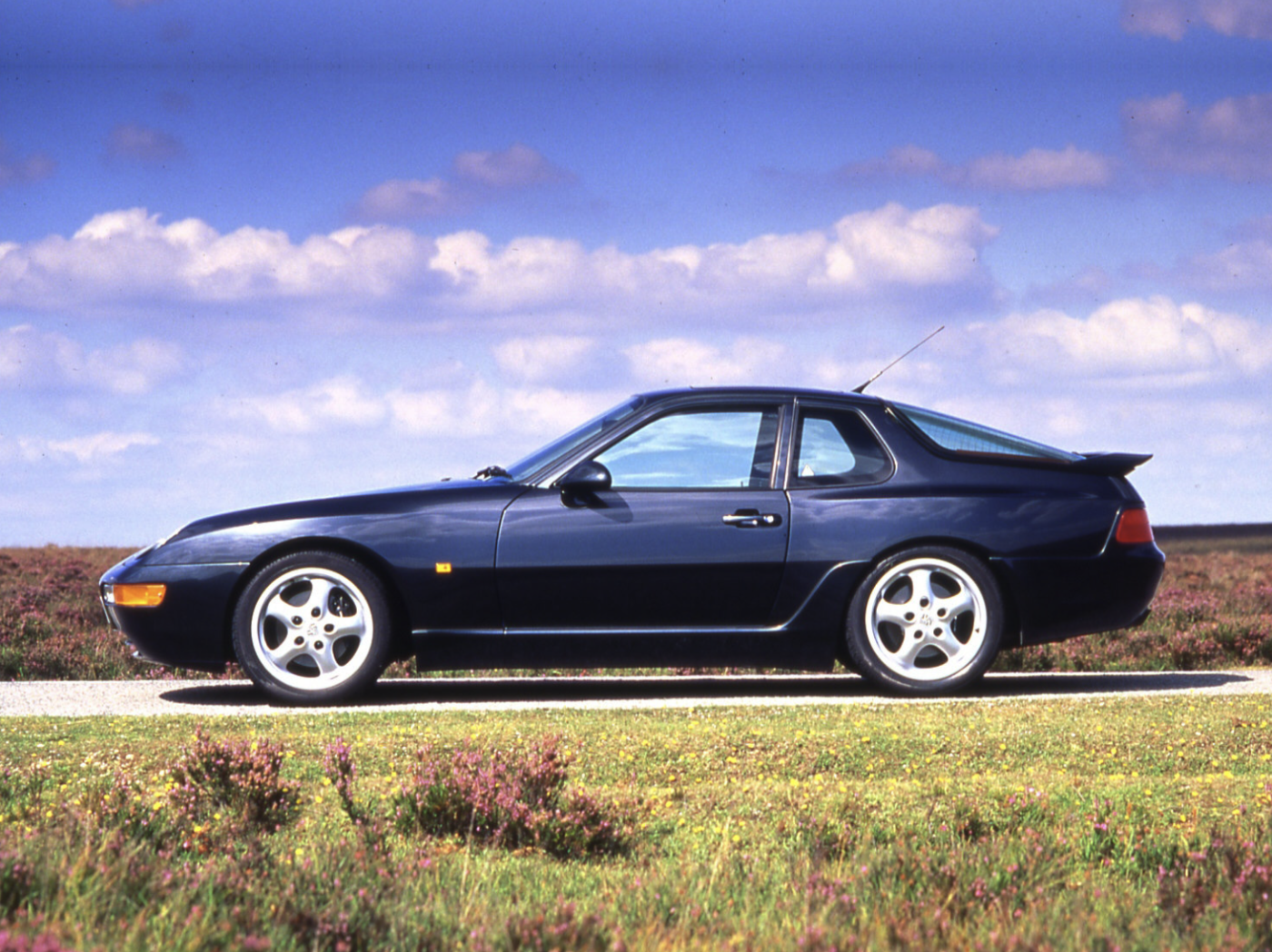
Porsche 968 Driving Experience & What to Expect
What They Said at The Time
When the Porsche 968 was released in the early 1990s, it received strong praise from journalists for its refined performance and balance, even if it struggled to stand out in a rapidly evolving sports car market. While it was built on the bones of the 944, critics noted that it felt like an entirely new car, with Porsche having upgraded over 80% of its mechanical components and introducing a cleaner, more modern design.
Road & Track called the 968 “the most balanced and user-friendly Porsche in the lineup,” highlighting its exceptional handling and usable power. They were impressed by the 3.0-liter four-cylinder engine, which at the time was the largest four-cylinder in production, producing smooth, linear torque that made the car both tractable in traffic and spirited on twisty roads. The six-speed manual transmission also received praise for being tight, mechanical, and satisfying to row through—a detail that enthusiasts still love today.
Car and Driver, in a comparison test, described the 968 as “a precision tool with real-world comfort,” emphasizing how it managed to straddle the line between performance and practicality. They admired the near-perfect weight distribution and noted that it handled “like a surgeon’s scalpel on winding roads.” However, the magazine also acknowledged its biggest challenge: price. At nearly $40,000 when new, it cost almost as much as a base 911, making it a hard sell despite its technical merits.
European outlets were equally enthusiastic. Autocar described it as “one of the most complete sports cars of the decade,” and praised its refinement and composure at speed. They particularly loved the Club Sport version, which dropped weight and sharpened dynamics even further. Even though the 968 was never a sales powerhouse, critics saw it for what it was: a deeply capable, underrated Porsche that deserved more attention than it got at the time.
In hindsight, much of that early praise has been validated. Today, the 968 is appreciated for exactly the reasons the magazines highlighted back then: its balance, engineering, and real-world usability. It may have lived in the shadow of the 911, but journalists knew all along that it was one of the best-driving Porsches of its era.
What to Expect Today
Driving a Porsche 968 is a masterclass in balance, refinement, and precision. As the final chapter in Porsche’s front-engine, transaxle story, it delivers a driving experience that feels both analog and surprisingly modern. While it’s often overshadowed by its 911 siblings, the 968 is in many ways a more approachable and better-balanced sports car, especially for those who value driver feedback over brute force.
At the core of the 968’s character is its 50:50 weight distribution, achieved through the front-engine, rear transaxle layout. This gives the car an incredibly neutral and planted feel through corners, with steering that’s precise and communicative, and handling that inspires confidence whether you're on a tight backroad or sweeping mountain pass. It’s not twitchy or overpowered—just beautifully composed. With the standard 3.0-liter, 16-valve inline-four producing 236 horsepower, the 968 offers strong midrange torque and smooth, predictable acceleration. 0–60 mph comes in around 6 seconds, and the six-speed manual transmission (standard on most coupes) is a joy to use—tight, mechanical, and direct.
As a daily driver, the 968 is surprisingly livable. It offers decent ride comfort, excellent visibility, and a practical hatchback design that makes it one of the most usable classic sports cars you can buy. The interior, though simple by modern standards, is well laid out and ergonomic. Cars with well-maintained air conditioning and working accessories make for solid commuters or tourers. Reliability is strong when maintenance is kept up, and the car’s layout makes it relatively easy to service compared to other Porsches of the era.
For most, though, the 968 shines brightest as a weekend car—something to savor on twisty roads or vintage rallies. It rewards smooth inputs and skillful driving more than raw aggression, making it ideal for those who want to feel connected to the car and the road. It’s quick enough to be engaging, but never intimidating, and it still turns heads with its timeless proportions and pop-up headlights.
The Porsche 968 offers a rare combination of performance, precision, and practicality, wrapped in a stylish and increasingly collectible package. It’s a car that feels special every time you drive it, but not so fragile or temperamental that you’ll hesitate to put miles on it. For buyers looking for a pure, analog sports car with modern reliability and a rising market profile, the 968 is one of the smartest choices in the classic Porsche world today.
Getting Real - Costs to Own & Maintenance
Owning a Porsche 968 offers a unique blend of everyday usability and classic Porsche charm—but it also requires a realistic understanding of maintenance and ownership costs. While more affordable than a 911 from the same era, the 968 is still a low-production, high-precision German sports car. The key to affordable ownership is buying a well-maintained example and staying on top of its preventative maintenance schedule.
Ownership Costs & Maintenance: What to Expect
The biggest recurring expense with the Porsche 968 is the timing belt and water pump service, which should be done every 4–5 years or 40,000 miles. This service is critical, as failure can result in serious engine damage—especially in interference engines like the 968’s 3.0L DOHC four-cylinder. Expect to pay between $1,200 and $2,000 for a full belt, roller, and water pump service at a reputable shop.
Other common maintenance costs include:
Clutch replacement (especially on higher-mileage cars): $2,000–$3,000
Suspension refresh (bushings, shocks, control arms): $1,500–$2,500
Brake system overhaul (rotors, pads, lines): $600–$1,200
Oil changes and fluids: $100–$300 depending on labor and parts
Electrical gremlins, aging interior plastics, and deteriorated rubber seals can also crop up, especially on cars that haven’t been driven regularly. That said, when maintained properly, the 968 is very reliable, thanks to its solid build quality and refined engineering.
Parts Availability & Pricing
Thanks to Porsche Classic and a strong enthusiast community, most parts are still available, especially for mechanical and drivetrain components. Items like belts, sensors, ignition components, and filters are relatively affordable and shared with other Porsche or VW/Audi models.
However, interior trim, exterior body panels, and some model-specific parts (like pop-up headlight mechanisms or rear hatch glass) can be hard to find and expensive. The limited production run means some parts may take time to source, especially for rarer trim pieces or cabriolet-specific items.
If originality is important to you—or if you're restoring a 968 to show-quality condition—be prepared to hunt for OEM parts or pay a premium for well-preserved used ones.
Insurance Costs for a Porsche 968
Insurance is generally reasonable, especially if you’re insuring the car as a classic or collector vehicle. Annual premiums for agreed-value policies usually range from $400 to $900, depending on your age, location, mileage, and the car’s insured value. If you're using the 968 as a daily driver, expect higher rates—more in the range of $1,000 to $1,500 per year with traditional full-coverage policies. Still, the 968’s reputation as a mature owner’s car helps keep rates lower than many modern sports cars.
Final Thoughts
The Porsche 968 is one of the most rewarding vintage sports cars to own if approached with the right mindset. Buy a clean, well-documented example, stay proactive with maintenance—especially timing belt services—and you'll be rewarded with a rare, well-balanced Porsche that offers excellent long-term value and a uniquely satisfying driving experience. It’s not “cheap,” but compared to the costs of air-cooled 911s or newer Porsches, the 968 offers a balanced ownership experience: classic Porsche character with reasonable upkeep—provided you respect the maintenance schedule.
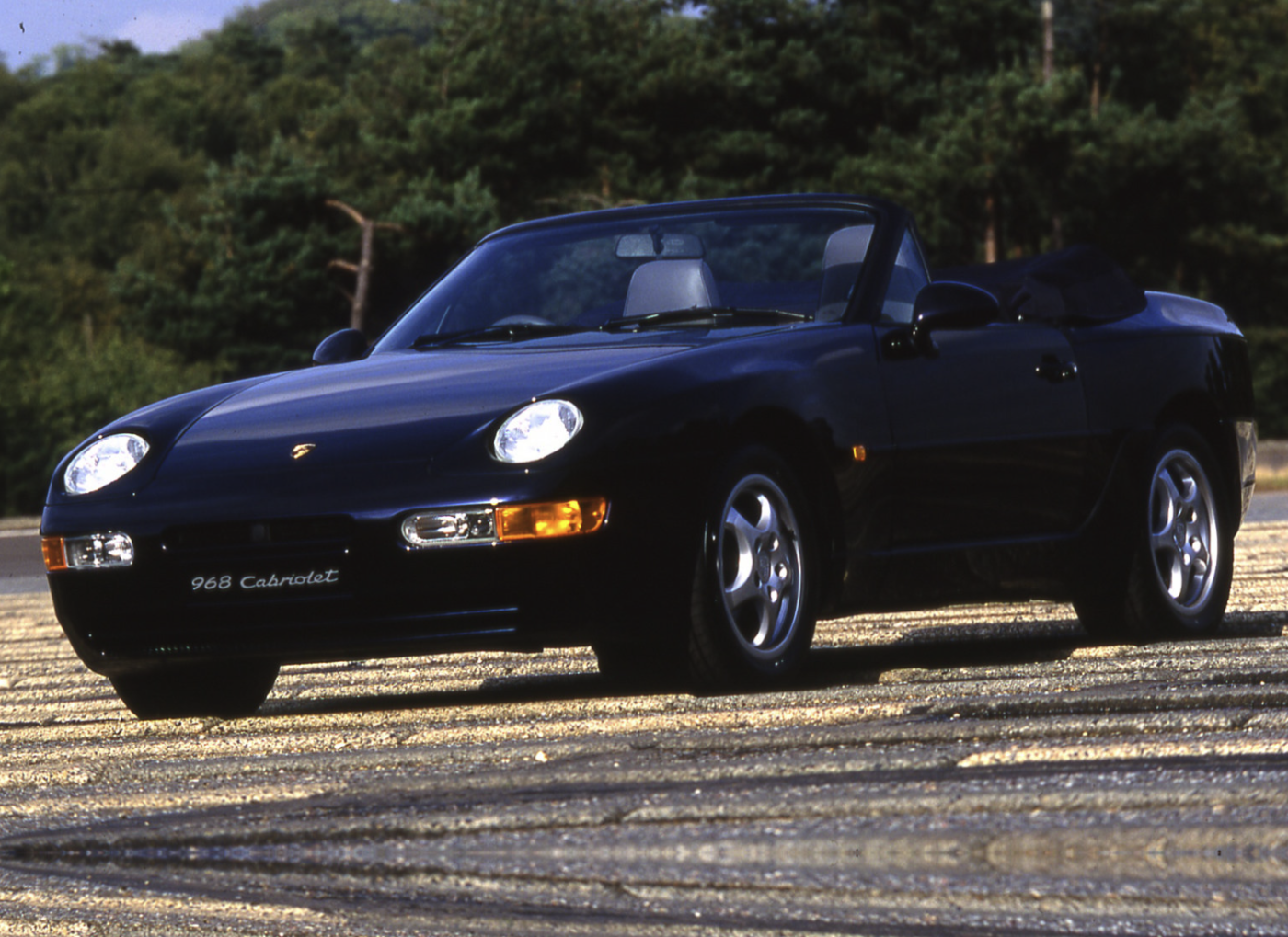
Other Key Buying Considerations
Ensuring Performance, Authenticity, and Long-Term Enjoyment
Buying a Porsche 968 isn’t just about finding a clean example—it’s about understanding the unique character of the car, its place in Porsche’s history, and the subtleties that separate a good purchase from a great one. Beyond mechanical condition and mileage, here are some critical buying considerations to keep in mind:
Coupe vs. Cabriolet
The 968 was offered in two body styles: coupe and cabriolet. Coupes are more desirable among enthusiasts for their structural rigidity and lower production numbers. While cabriolets offer top-down enjoyment, they’re slightly heavier and have additional points of failure (like power tops and weather seals). That said, a manual cabriolet in a rare color with proper care can still be a smart buy—especially as a stylish, weekend cruiser.
Manual vs. Tiptronic Transmission
Manual-transmission cars are far more desirable, both in terms of driving engagement and long-term value. The 6-speed manual (unique to the 968) is slick, mechanical, and a joy to use. The 4-speed Tiptronic automatic, while smooth, dulls the driving experience and significantly affects resale value. If you’re buying as an enthusiast or investor, always prioritize a manual unless a cabriolet Tiptronic is priced attractively for cruising purposes.
Documentation and Provenance
A car with a detailed maintenance history and long-term ownership is worth significantly more than one with missing paperwork. Look for cars with service records showing regular timing belt replacements, clutch work, and suspension service. Original window sticker, manuals, tool kit, and even dealer paperwork add to both confidence and collectibility.
Factory Options and Color
Color can make a huge difference on a 968. Rare colors like Speed Yellow, Maritime Blue, Amazon Green, or Amethyst Metallic are much more desirable than more common shades like black, white, or red. Options like limited-slip differential (M220), sport seats, and 17-inch Cup wheels also add value and appeal—especially to future buyers or collectors.
Originality vs. Modifications
Like with most classic Porsches, originality is king. A stock 968 in good condition will typically outpace a modified one in terms of value. Mild upgrades (like modern stereo systems, suspension refreshes, or period-correct wheels) are usually acceptable, but engine swaps, body kits, or hacked interiors should be avoided if you care about long-term value or originality.
Rust and Body Condition
Although not especially rust-prone, 968s are now 30+ years old, and rust can appear in wheel arches, sills, the battery tray, hatch seams, and under the car—especially in colder climates or on cars that have been neglected. Always inspect thoroughly or get a pre-purchase inspection (PPI) from a shop familiar with Porsche transaxles.
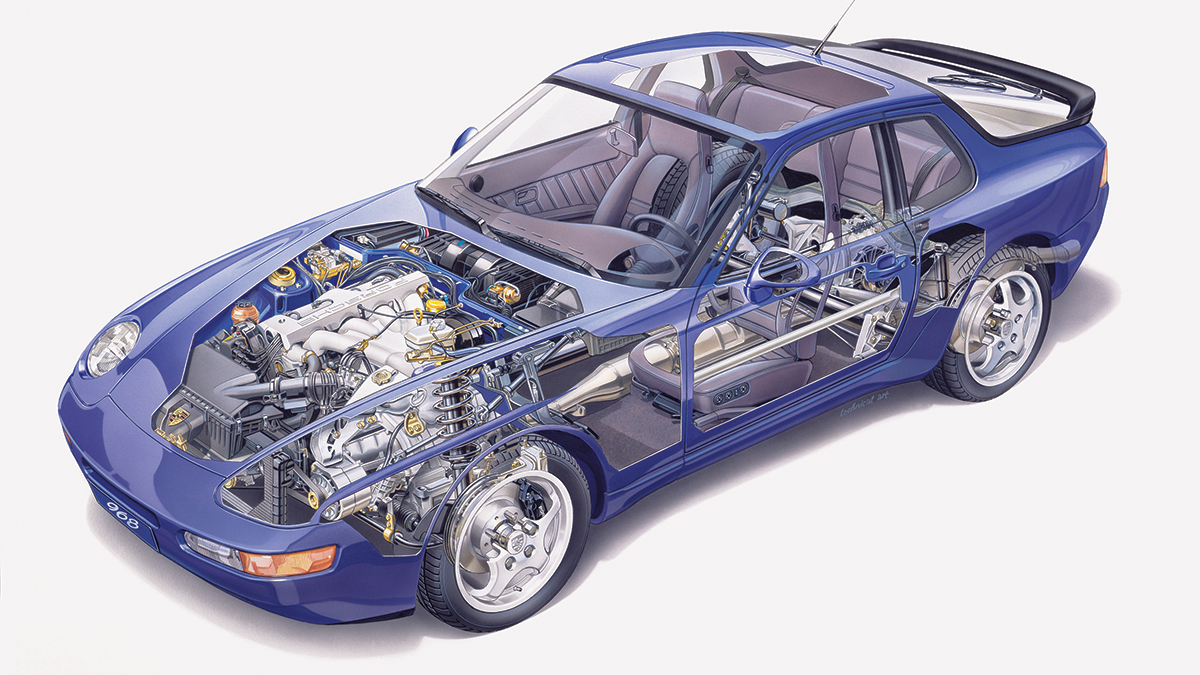
Common Porsche 968 Problems
What Buyers Should Know
While the Porsche 968 is known for its overall reliability and refinement—especially compared to earlier transaxle models—it’s still a 30+ year-old German sports car with specific quirks and aging components to be aware of. A well-maintained 968 can be an incredibly rewarding car to own, but buying the wrong one can lead to frustrating expenses. Here are the most common issues and red flags to look for when evaluating a 968.
(see our full article on common Porsche 968 problems here).
1. Timing Belt and Balance Shaft Belt Neglect
The most critical maintenance item on a 968 is the timing belt, which should be replaced every 4–5 years or 40,000 miles, along with the water pump, tensioners, and rollers. The 3.0L DOHC engine is an interference design—meaning if the belt breaks, it can cause catastrophic internal engine damage. The balance shaft belt is also vital to keep engine vibration in check. Look for documentation of recent belt service. If there’s no proof it’s been done, factor in $1,500–$2,000 to have it done immediately.
2. Clutch Wear and Failure
Clutches on the 968 can last a long time, but when they wear out, replacement is expensive due to the transaxle layout and labor involved. Symptoms of wear include slipping under load, a high engagement point, or juddering during takeoff. Look for smooth clutch operation and clean gear changes. Ask when it was last replaced, especially on cars with over 100,000 miles.
3. VarioCam System Issues
The 968’s VarioCam system, which adjusts cam timing for better low-end torque, can wear out or fail. When this happens, performance suffers, and the car may run rough or throw engine codes. The system uses an oil-driven solenoid and cam chain tensioner that should be checked during major services. Check for a noisy timing cover area (possible chain slap), poor throttle response, or lack of midrange torque could indicate issues with the VarioCam system.
4. Electrical Gremlins
As with most older European cars, the 968 can develop minor electrical problems over time. Aging wiring, dirty grounds, or failing relays can lead to intermittent issues with lights, gauges, windows, sunroofs, and HVAC controls. Test all electronics, including the sunroof, power mirrors, windows, seat adjustments, and lights. Look under the dash for evidence of previous wiring repairs or poor modifications.
5. Oil Leaks and Seepage
While many 968s develop minor oil leaks as they age, some leaks can point to more serious issues like cam cover gasket failure or rear main seal problems. A leaking rear main seal is especially expensive due to the labor involved in accessing it (the transmission must be removed). Check under the car and near the bell housing for fresh oil spots. A small seep is common; puddles or active drips warrant further inspection.
6. Suspension and Bushing Wear
Over time, suspension bushings, shocks, ball joints, and control arms wear out, especially on cars that have been driven hard or haven’t had a recent suspension refresh. Worn bushings can lead to vague handling, clunking, and uneven tire wear. Listen for suspension noise over bumps and feel for looseness in the steering or vibration at speed. A crisp 968 should feel tight and responsive.
7. Hatch Seal and Rear Glass Separation
A known issue on all transaxle Porsches, including the 968, is delamination of the rear hatch glass from the frame, which can lead to leaks and rattles. The rubber seal also often deteriorates with age. Inspect the rear hatch glass for separation or fogging around the edges. Press gently on the glass to see if it moves independently of the frame.
Buying A Porsche 968 FAQs
Here are all the questions we've received from readers considering a Porsche 968 for their garage
What to look for when buying a 968 in terms of authenticity & documentation
When considering a Porsche 968 purchase, authenticity and documentation should be near the top of your checklist—especially if you're hoping to buy a clean, investment-worthy example. While the 968 isn't as heavily scrutinized by collectors as the 911, a properly documented, original car will hold its value better, be easier to insure, and often reflects a history of careful ownership. In a market where many 968s have been neglected, modified, or cobbled together from multiple cars, verifying the car’s identity and its paper trail is essential. Here's how to approach it like a seasoned buyer.
1. Matching VINs and Identification Numbers
When considering the purchase of a Porsche 968, evaluating authenticity and documentation is just as important as assessing the car’s mechanical condition. A well-documented, original 968 will not only give you peace of mind as an owner, but it will also be worth more long-term and will be easier to sell if and when the time comes. Here's what to focus on:
1. VIN Verification & Matching Numbers
Start with the basics: make sure the Vehicle Identification Number (VIN) matches on the title, the chassis, and the option sticker (usually found in the rear hatch or service book). For more collectible variants it’s also worth confirming that the engine, transmission, and major components are original or period-correct. Matching numbers can significantly impact value, especially as 968s become more collectible.
2. Original Options Sticker & Build Codes
The 968’s factory option sticker (usually in the rear hatch area or inside the service book) lists the M-code options and original color codes. This helps you confirm the original paint color, interior trim, and special equipment. Use an online M-code decoder or Porsche reference guide to verify authenticity, particularly on rarer cars like Turbos or special editions.
3. Paint & Interior Consistency
Originality often comes down to the details. Is the paint consistent with factory color codes? Are the seats, dash, and steering wheel correct for the year and model? Heavily altered interiors, aftermarket paint jobs, or swapped parts may lower collectability. Minor upgrades are fine, but a 968 that looks and feels like it did when it left the factory is almost always worth more.
4. Complete Service History
A binder of receipts, service logs, and ownership records is a big plus. Key items to look for include:
Timing belt and water pump replacements
Clutch and transmission work
Suspension refreshes
Cooling system repairs
Turbocharger rebuilds
Bonus points if the car has the original stamped service book, owner’s manual, window sticker, tool kit, and even original keys.
5. Clean Title & Ownership Chain
A clean title with no salvage history is critical. Try to get a sense of ownership history—cars with long-term owners tend to be better maintained. If you're dealing with multiple prior owners and no paper trail, tread carefully.
6. Factory vs. Aftermarket Modifications
A lightly modified 968 (such as upgraded shocks or a modern stereo) may not be a dealbreaker, but heavy modifications can complicate authenticity and reduce resale appeal—especially if original parts aren’t included in the sale. Collectors tend to prefer unmolested examples, especially in rare or desirable trims.
Final Thoughts
The best Porsche 968s are those with a clear story, verified originality, and comprehensive documentation. These cars are increasingly appreciated by collectors and enthusiasts alike, and originality is becoming a bigger piece of the puzzle. When you find a car that looks right, checks out on paper, and has the records to back it up, you’re not just buying a fun car—you’re buying a piece of Porsche history that’s only becoming more valuable.
Just how important are service records and ownership history?
Service records and ownership history are absolutely essential when evaluating a Porsche 968—arguably more so than mileage or even cosmetic condition. The 968 is a finely engineered, relatively rare Porsche, and like any aging high-performance vehicle, it requires diligent, ongoing maintenance to stay in top form. A car with a thick folder of service receipts and a well-documented chain of ownership is a much safer and smarter buy than one without.
The most important maintenance item is the timing belt and water pump service, which should be performed every 4–5 years or 40,000 miles. This isn’t just a routine job—it’s critical, as failure can result in catastrophic engine damage. Without records, you’re left guessing whether this and other key services (like clutch replacement, suspension work, or VarioCam servicing) have been done. And those jobs aren't cheap. So having documentation offers real peace of mind and significantly protects your investment.
Ownership history also adds value. A car that’s had a few careful, long-term owners is usually in better condition and has been more thoughtfully maintained than one that’s changed hands frequently. It can also help verify mileage, paint originality, and option authenticity.
In today’s rising 968 market, service records and ownership history aren't just “nice to have”—they’re vital. Well-documented cars command higher prices, sell faster, and offer more confidence to both first-time buyers and seasoned collectors. If a car doesn’t have records, assume you’ll need to budget for everything—and negotiate accordingly.
Originality vs. Modified Examples: What’s More Valuable?
When it comes to Porsche 968s, originality is generally more valuable—especially as these cars continue to gain traction among collectors and enthusiasts. Like most classic Porsches, the 968’s long-term appeal and market value are closely tied to how closely a car resembles its factory configuration. That means original paint, factory interior, matching-numbers drivetrain, and period-correct options tend to bring stronger prices and greater interest, especially from buyers who are seeking investment-grade or collectible examples.
Unmodified, low-mileage coupes with manual transmissions and rare color combinations or factory options (like the limited-slip differential or sport seats) are at the top of the market. These cars are more desirable because they offer a window into Porsche’s engineering at the end of the transaxle era—when everything had been refined and perfected. For purists and collectors, originality also represents authenticity and trust, which translates directly to higher resale value and appreciation potential.
That said, not all modifications are negative—tasteful, well-documented upgrades can be a plus for enthusiasts looking to enjoy the 968 as a driver. Modern suspension components, upgraded stereo systems, or subtle performance tweaks (like bushings or shifters) may improve the driving experience without harming value too much, especially if original parts are included. However, extensive mods—like engine swaps, wild body kits, or stripped interiors—typically hurt value, narrowing your buyer pool and diminishing the car’s historical appeal.
In short, if you're buying a 968 with future collectibility and investment in mind, choose originality every time. If you’re buying to drive and enjoy without concern for concours points, a lightly modified car might offer more fun for less money—but be sure the work was done right, and understand that resale may take longer and yield less.
What are the most sought after Porsche 968 variants?
The most sought-after Porsche 968 variants are those that combine rarity, performance, and collector appeal. While all 968s offer a unique blend of refinement and transaxle engineering excellence, a few stand out in the eyes of collectors and enthusiasts due to limited production numbers, performance pedigree, or market desirability. Here's a breakdown of the most desirable 968 variants:
1. Porsche 968 Club Sport (1993–1995, Europe Only)
The 968 Club Sport (CS) is widely considered the holy grail of the lineup. Built for performance enthusiasts, it featured weight reduction, stripped interiors, manual windows, fixed-back Recaro seats, and M030 sport suspension. It was track-focused from the factory and never officially sold in the U.S., making it highly collectible today, especially in bold colors like Speed Yellow or Riviera Blue. Fewer than 2,000 were produced.
2. Porsche 968 Turbo S and Turbo RS (1993–1994, Extremely Limited)
These are the rarest and most powerful 968s ever built, intended for racing homologation and motorsport. The Turbo S made around 305 hp and featured a 3.0L turbocharged engine derived from the 944 Turbo S setup. Only 14 Turbo S models and a handful of RS race cars were produced, all factory-built. These cars rarely come to market and are well into six-figure territory—true unicorns for Porsche collectors.
3. Porsche 968 Coupe (Manual Transmission, 1992–1995)
Among standard models, the manual-transmission coupe is the enthusiast’s choice. It’s the purest form of the 968 with a rigid chassis, smooth 6-speed manual, and balanced handling. Well-maintained, low-mileage, original coupes—especially in rare factory colors and with desirable options like limited-slip differential (M220)—are climbing quickly in value.
4. Porsche 968 Cabriolet (Manual, 1992–1995)
While cabriolets aren’t usually top-tier in collector circles, manual-transmission 968 cabriolets are increasingly sought after due to their rarity and usability. Automatics are far more common, so a clean, documented manual cabriolet in a rare color combo is considered a great buy for open-top Porsche fans and long-term collectors alike.
5. Final-Year Models (1994–1995)
The later production years of the 968 tend to be better sorted and often came with desirable options. Because production dropped toward the end of the model run, 1994–1995 cars are naturally rarer. Coupled with lower mileage and full documentation, these late-year examples are increasingly in demand.
If you're chasing collectibility, look for factory-original, low-mileage examples—especially coupes with manuals and rare color/option combinations. The Club Sport and Turbo variants are at the top of the collector pyramid, but even standard 968s are rising fast in the classic Porsche world. With limited production and a growing enthusiast following, the best examples are becoming harder to find—and more valuable by the year.
What are the most popular Porsche 968 colors?
The Porsche 968 was offered in a wide range of vibrant and classic colors throughout its production from 1992 to 1995, with several hues becoming especially sought after by collectors and enthusiasts today. While some colors were more common, others were rare, region-specific, or part of limited production runs—making them highly desirable today. Here are some of the most popular and notable Porsche 968 colors:
1. Guards Red (L80K). One of the most iconic Porsche colors, Guards Red was a popular choice for the 968. Bold, sporty, and very ‘90s, it perfectly complements the clean, sculpted lines of the car. It’s also one of the most frequently seen colors on 968 coupes and cabriolets.
2. Midnight Blue Metallic (L39C). Elegant and timeless, Midnight Blue Metallic was another favorite. It pairs beautifully with both light and dark interiors and gives the 968 a more understated, refined look.
3. Speed Yellow (L12G). Bright, loud, and very rare, Speed Yellow was mostly seen on special models like the Club Sport and some later European-market cars. Today, it’s one of the most collectible 968 colors due to its scarcity and eye-catching appearance.
4. Riviera Blue (L39E). One of Porsche’s most legendary paint colors, Riviera Blue is incredibly rare on the 968. It was more commonly seen on later 911 and Boxster models but occasionally appeared on 968s—particularly Club Sports and special-order cars. It's now one of the most prized hues for collectors.
5. Amethyst Metallic (L38A). This unique purple-toned metallic paint gives the 968 a distinctive and luxurious vibe. Rare and unusual, Amethyst has grown in popularity among collectors looking for unique, period-correct flair.
6. Polar Silver Metallic (L92M). Sleek and modern-looking, Polar Silver was a popular but elegant choice that has aged well. It offers a nice balance between subtlety and sophistication.
7. Amazon Green Metallic (L96Q). A dark, rich green that was fairly uncommon, Amazon Green Metallic is a favorite among enthusiasts who appreciate unique, deep color tones. It’s especially striking when paired with tan or linen interiors.


